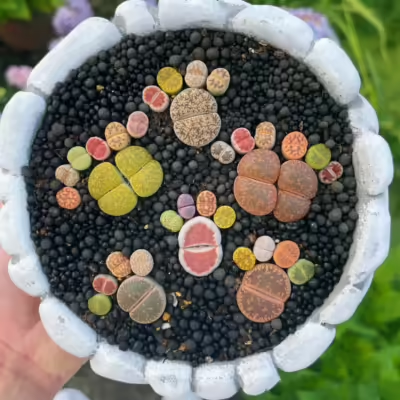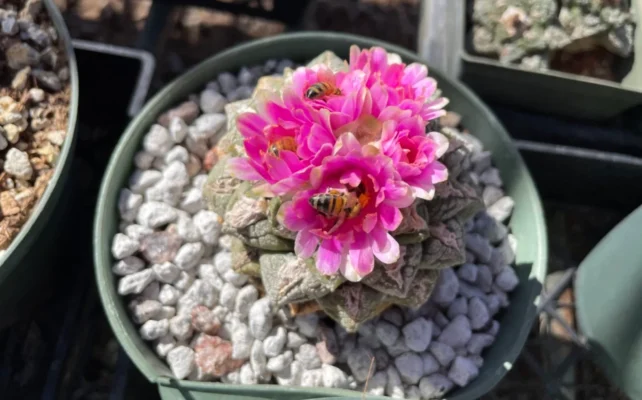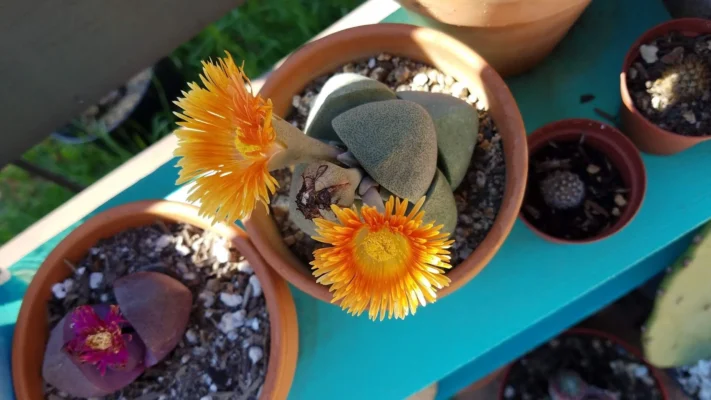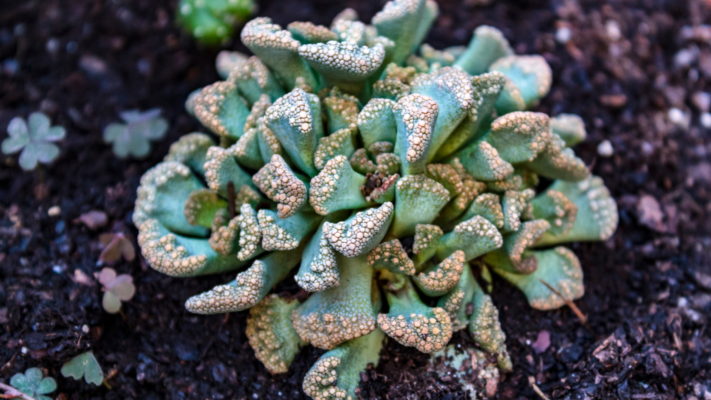For our plant enthusiasts and collectors, adding unique and rare houseplants to their collection is always exciting. Among the most intriguing varieties are rock-shaped rare plants. These fascinating plants mimic the appearance of rocks, seamlessly blending into natural landscapes and adding a unique aesthetic to any indoor garden. In today’s reading, I’ll bring you 5 stunning rock-shaped rare plants that will captivate any plant lover’s heart and inspire you to add them to your collection.
5 Rock-Shaped Rare Plants You Need in Your Collection
Double-headed Lithops (Living Stones)
Lithops, commonly known as Living Stones, are small succulents that closely resemble pebbles or stones. Their unique camouflaging ability helps them blend into their natural rocky environments. Double-headed Lithops are especially fascinating, as they feature two heads growing from a single root system, creating an even more rock-like appearance.

Care Tips:
- Light: Requires bright, direct sunlight.
- Water: Water sparingly, allowing the soil to dry out completely between waterings. Overwatering can be fatal.
- Soil: Use well-draining, sandy soil.
These cuties are a catch, and especially, not that difficult to find. Lithops – Living stones is on Etsy for only $6.90, fair price for this mad cuteness! Purchase for a double-head plant: ~ 2.4cm / 1 inches, or 6 small plants: ~ 1 cm / 0.5 inches.
Add these fascinating Living Stones to your collection today!
Pleiospilos nelii (Split Rock)
Pleiospilos nelii, also known as Split Rock, is a succulent that looks remarkably like a rock split in half. Its gray-green leaves have a textured surface that helps it blend into its natural habitat. When in bloom, Pleiospilos nelii produces stunning daisy-like flowers that add a burst of color to its rocky appearance.
Care Tips:
- Light: Prefers bright, indirect light.
- Water: Water infrequently, allowing the soil to dry out between waterings.
- Soil: Needs well-draining soil, such as a cactus or succulent mix.
A healthy plant with a well-established root system, Split Rock is also an easy-care treasure I have always long for my home. Now that I found one that perfectly fit to my place, it’s your turn to have it too! This rare type is Etsy for $12.00 and it is worth its price.
Bring home this intriguing Split Rock plant here!
Ariocarpus fissuratus (Living Rock Cactus)
Ariocarpus fissuratus, commonly known as Living Rock Cactus, is a unique cactus that has a rock-like appearance. This slow-growing cactus features rough, textured surfaces that blend well with rocky environments. Ariocarpus plants are highly sought after for their striking, vibrant flowers that emerge from the center of the plant.

Care Tips:
- Light: Requires full sun.
- Water: Water sparingly, especially during the winter months when the plant is dormant.
- Soil: Use a gritty, well-draining soil mix.
This beauty is rare and so unique that I spent lots of time tryna grow it. The process is not easy, but the outcome is magnificent! For this Living Rock Cactus’s seeds, you’ll get it on Etsy for $12.00. As plant lovers, we all want to own a pretty plant that we can also brag about to others: “I raise it myself!”. Get these seeds and make it happen today.
Add this unique cactus to your collection!
Titanopsis calcarea
Titanopsis calcarea is a small succulent that resembles limestone or gravel. Its warty, rough-textured leaves help it blend into rocky environments. This plant is often admired for its unusual and distinctive appearance, making it a great addition to any rare plant collection.
Care Tips:
- Light: Prefers bright, indirect light.
- Water: Water infrequently, allowing the soil to dry out between waterings.
- Soil: Requires well-draining soil.
You can get a Titanopsis calcarea easily on Etsy for only $6.79. It also comes with a 2” pot for your preference.
Discover the beauty of this rock-like succulent here!
Conophytum Pageae
Conophytum Pageae is a small succulent that grows in clusters, resembling a pile of small stones or pebbles. The smooth, rock-like leaves of this plant come in various colors and patterns, adding a unique aesthetic to any indoor garden. Conophytum Pageae is especially popular for its compact size and ease of care.
Care Tips:
- Light: Needs bright, indirect light.
- Water: Water sparingly during the growing season and keep dry during dormancy.
- Soil: Use well-draining, sandy soil.
These funny little ones fit with weird-soul and it shows! If you want to plant yourself a plant like this, get those seeds on Etsy for $6.39. All the seeds are from the latest harvest and excellent germination can be guaranteed.
Add this rare gem to your collection today!
FAQs
Q: What are the best conditions for growing rock-shaped plants?
A: Rock-shaped plants generally thrive in bright, indirect light, with some requiring direct sunlight. They prefer well-draining soil and minimal watering, making them ideal for dry, desert-like conditions.
Q: How do I propagate rock-shaped plants?
A: Propagation methods vary by species, but many rock-shaped plants can be propagated through seed sowing, leaf cuttings, or division. Refer to specific propagation guides for each plant for best results.
Q: Where can I buy rare rock-shaped plants online?
A: Online retailers like Etsy offer a variety of rare rock-shaped plants. Additionally, specialized succulent and cactus nurseries often have a selection of these unique plants.
Q: Are rock-shaped plants difficult to care for?
A: Rock-shaped plants are generally low-maintenance and easy to care for, making them perfect for both beginners and experienced plant enthusiasts. Their minimal water requirements and hardy nature make them ideal for busy individuals.
Rock-shaped rare plants are a fantastic way to bring nature’s unique beauty into your home. These intriguing plants not only enhance your decor but also offer a rewarding and enjoyable gardening experience. Start your collection today and transform your indoor space into a mesmerizing display of natural artistry.
Visit the links above to shop for your favorites and elevate your indoor garden with the mesmerizing beauty of rock-shaped rare plants. If you’re looking to further expand your collection with unique greenery, don’t forget to explore more rare house plants for an even more diverse and intriguing plant collection.





